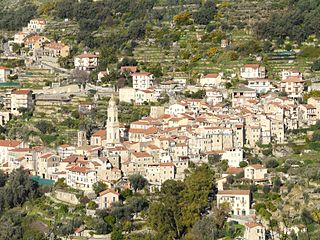| Borghetto San Nicolò | |
|---|---|
| Frazione | |
Overall view | |
| Coordinates: 43°48′17.72″N7°39′37.28″E / 43.8049222°N 7.6603556°E Coordinates: 43°48′17.72″N7°39′37.28″E / 43.8049222°N 7.6603556°E | |
| Country | |
| Region | |
| Province | Imparia (IM) |
| Comune | Bordighera |
| Elevation [1] | 90 m (300 ft) |
| Population (2001)Istat - 14º Censimento generale della popolazione e delle abitazioni | |
| • Total | 312 |
| Time zone | CET (UTC+1) |
| • Summer (DST) | CEST (UTC+2) |
| Postal code | 18012 |
| Dialing code | (+39) 0184 |
| Patron saint | Saint Nicholas |
| Saint day | 6 December |
Borghetto San Nicolò is a frazione (and parish) of the municipality of Bordighera, in Liguria, northern Italy.
"Frazione" is the Italian name given in administrative law to a type of territorial subdivision of a comune; for other administrative divisions, see municipio, circoscrizione, quartiere. It is cognate to the English word fraction, but in practice is roughly equivalent to "parishes" or "wards" in other countries.
A parish is a territorial entity in many Christian denominations, constituting a division within a diocese. A parish is under the pastoral care and clerical jurisdiction of a parish priest, who might be assisted by one or more curates, and who operates from a parish church. Historically, a parish often covered the same geographical area as a manor. Its association with the parish church remains paramount.

Bordighera is a town and comune in the Province of Imperia, Liguria (Italy).




























